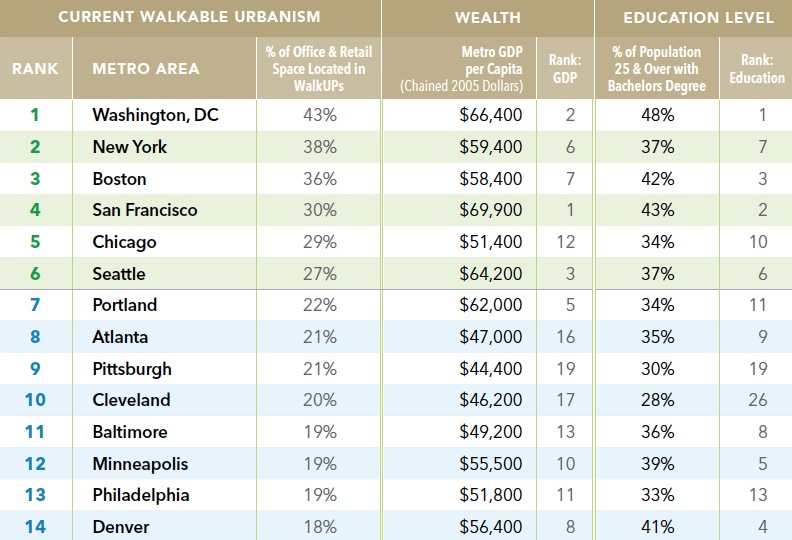A focus on dense, walkable development allows cities to pack more economic punch per square foot, according to a new study. In Washington DC, deemed the most walkable U.S. city, the most walkable areas in the city take up less than one per cent of the total acreage, but represent almost half of the most wealth-generating square footage for the whole city.
The study was authored by the Center for Real Estate and Urban Analysis at George Washington University School of Business in conjunction with LOCUS: Responsible Real Estate Developers and Investors. It’s an initiative of Smart Growth America, which also co-authored a great study on pedestrian safety earlier this year. They have taken a different path to determine a metropolitan area’s walkability, which helps to illustrate how, exactly, a more walkable place is more financially lucrative for a city.
Instead of isolating city vs. suburb, as many studies tend to do, this study acknowledges that there can be drivable communities in urban centres and walkable communities in exurbs, but that places with good walkability share common qualities: high density, a mix of real estate uses, multiple transportation options, and the ability to serve the daily needs of residents largely on foot.

To find the most walkable places in the country, rather than looking simply at a city’s center, the study looked at places where walkability intersects with regional significance, meaning these are places where economy-driving development is creating wealth for these areas. They have used data from several sources including real estate values, transit information, WalkScore rankings, and census studies to locate 558 “WalkUPs,” or walkable urban places, across the country, and 30 metropolitan areas are ranked by measuring the total number of office and retail square footage — the capacity for generating wealth — in those WalkUPs.
Washington DC ranks first — yes, over New York City — because of its many walkable centres which are easily connected with transit. Boston, San Francisco and Chicago round out the top five. The cool thing about examining walkability within the context of real estate is that the study can also examine the potential for walkability, so the study has also forecast which cities will be more walkable in the future. (Spoiler: Boston supplants DC as the top city.)

But the most interesting part is seeing how those WalkUP figures correlate with GDP and education level. In almost every case, a higher walkability index means more income per capita and higher educational attainment. The top ranking metropolitan areas have an average of 38 per cent higher GDP per capita as compared to the low ranking metros, and 74 per cent higher real estate values.
Urbanists have long tried to highlight the correlation between walkability and economic success as a way to encourage cities to incentivise denser, more transit-accessible development. Here it’s clear that walkable urbanism is a key component to building the places that people want to live, shop and work — both making and spending their money. [Smart Growth America]
